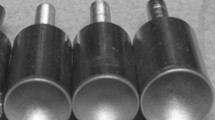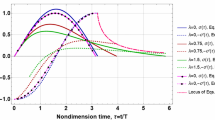Abstract
The in-plane impact and crushing properties have been studied for the Semi Reentrant structure (SRS) by using numerical simulations and theoretical studies. Different deformation modes during impact process could be observed under the various impact velocities, and there were three and two deformation modes in x1 and x2 directions, respectively, no matter for single or double sidewall conditions. The influence of arm length l and cell wall thickness t on the critical impact velocities of different deformation modes was investigated. With the increase of cell wall thickness, the critical velocity in both directions increased and power-law relations could be established. With the increase of inclined arms length l, the critical velocity in x1 direction was almost the constant while that in x2 direction generally decreased and was described by the power-law relationship. The influence of impact velocity on the dynamic elastic moduli was studied and the fitting curves between the normalized velocity and moduli were characterized by using piecewise functions. Moreover, the effect of impact velocity on the plateau stress, densification strain and densification strain energy were also analyzed, and related fitting expressions were obtained. Besides, theoretical models for predicting static and dynamic plateau stress and densification strain energy for SRS were established based on the previous study. The analytical model of dynamic plateau stress was then revised according to the fitting equations with a large enhancement of predicting accuracy.















Similar content being viewed by others
References
Tianjian L (2002) Ultralight porous metals: from fundamentals to applications. Acta Mech Sin 18(5):457–479
Zhu F et al (2009) Analytical investigation and optimal design of sandwich panels subjected to shock loading. Mater Des 30(1):91–100
Fleck NA, Deshpande VS (2004) The resistance of clamped sandwich beams to shock loading. J Appl Mech 71(3):386–401
Gibson LJ, Ashby MF (1999) Cellular solids: structure and properties. Cambridge University Press, Cambridge
Hu LL, Yu TX (2010) Dynamic crushing strength of hexagonal honeycombs. Int J Impact Eng 37(5):467–474
Dharmasena K et al (2009) Dynamic response of a multilayer prismatic structure to impulsive loads incident from water. Int J Impact Eng 36(4):632–643
Xue Z, Hutchinson JW (2004) A comparative study of impulse-resistant metal sandwich plates. Int J Impact Eng 30(10):1283–1305
Rathbun HJ et al (2006) Performance of metallic honeycomb-core sandwich beams under shock loading. Int J Solids Struct 43(6):1746–1763
Ruan D et al (2003) In-plane dynamic crushing of honeycombs—a finite element study. Int J Impact Eng 28(2):161–182
Liu Y, Zhang X (2009) The influence of cell micro-topology on the in-plane dynamic crushing of honeycombs. Int J Impact Eng 36(1):98–109
Hu LL, Yu TX (2010) Dynamic crushing strength of hexagonal honeycombs. Int J Impact Eng 37(5):467–474
Hu LL, Yu TX (2013) Mechanical behavior of hexagonal honeycombs under low-velocity impact–theory and simulations. Int J Solids Struct 50(20–21):3152–3165
Gibson LJ et al (1982) The mechanics of two-dimensional cellular materials. Proc R Soc Lond A Math Phys Sci 382(1782):25–42
Robert F (1985) An isotropic three-dimensional structure with Poisson’s ratio = – 1. J Elast 15(4):427–430
Huang X, Blackburn S (2002) Developing a new processing route to manufacture honeycomb ceramics with negative Poisson’s ratio. Key Eng Mater 206(213):201–204
Lakes RS, Elms K (1993) Indentability of conventional and negative Poisson’s ratio foams. J Compos Mater 27(12):1193–1202
Lakes R (1987) Foam structures with a negative Poisson’s ratio. Science 235:1038–1041
Scarpa F, Ciffo LG, Yates JR (2003) Dynamic properties of high structural integrity auxetic open cell foam. Smart Mater Struct 13(1):49
Evans KE (1990) Tailoring the negative Poisson ratio. Chem Ind 20:654–657
Mukhopadhyay T, Adhikari S (2016) Effective in-plane elastic properties of auxetic honeycombs with spatial irregularity. Mech Mater 95:204–222
Boldrin L et al (2016) Dynamic behaviour of auxetic gradient composite hexagonal honeycombs. Compos Struct 149:114–124
Xiao D et al (2019) Compression behavior of the graded metallic auxetic reentrant honeycomb: experiment and finite element analysis. Mater Sci Eng A 758:163–171
Zhang X et al (2015) The influence of cell micro-structure on the in-plane dynamic crushing of honeycombs with negative Poisson’s ratio. J Sandwich Struct Mater 17(1):26–55
Ruan D et al (2003) In-plane dynamic crushing of honeycombs—a finite element study. Int J Impact Eng 28(2):161–182
Hou X, Deng Z, Zhang K (2016) Dynamic crushing strength analysis of auxetic honeycombs. Acta Mech Solida Sin 29(5):490–501
Zhang J et al (2018) Tensile behavior of an auxetic structure: analytical modeling and finite element analysis. Int J Mech Sci 136:143–154
Zhang J et al (2018) Large deformation of an auxetic structure in tension: experiments and finite element analysis. Compos Struct 184:92–101
Imbalzano G et al (2017) Three-dimensional modelling of auxetic sandwich panels for localised impact resistance. J Sandwich Struct Mater 19(3):291–316
Imbalzano G et al (2018) Blast resistance of auxetic and honeycomb sandwich panels: comparisons and parametric designs. Compos Struct 183:242–261
Reid SR, Peng C (1997) Dynamic uniaxial crushing of wood. Int J Impact Eng 19(5–6):531–570
Hu LL, Zhou MZ, Deng H (2018) Dynamic crushing response of auxetic honeycombs under large deformation: theoretical analysis and numerical simulation. Thin-Walled Struct 131:373–384
Hu L, You F, Yu T (2013) Effect of cell-wall angle on the in-plane crushing behaviour of hexagonal honeycombs. Mater Des 46:511–523
Lee W et al (2019) Effect of auxetic structures on crash behavior of cylindrical tube. Compos Struct 208:836–846
Zhou Z, Zhou J, Fan H (2017) Plastic analyses of thin-walled steel honeycombs with re-entrant deformation style. Mater Sci Eng A 688:123–133
Dong Z et al (2019) Experimental and numerical studies on the compressive mechanical properties of the metallic auxetic reentrant honeycomb. Mater Des 182:108036
Grima JN, Oliveri L, Attard D et al (2010) Hexagonal honeycombs with zero Poisson’s ratios and enhanced stiffness. Adv Eng Mater 9(12):855–862
Grima JN, Oliveri L, Attard D (2009) Paper presented at the 6th international workshop on auxetics & related systems. Bolton (UK)
Davini C et al (2017) A 2D microstructure with auxetic out-of-plane behavior and non-auxetic in-plane behavior. Smart Mater Struct 26(12):125007
Sun DQ, Zhang WH (2008) In plane impact properties of aluminum double walled honeycomb cores. J Vib Shock 27(7):69–74
Acknowledgements
The author would like to acknowledge the support from the Fundamental Research Funds for the Central Universities (Grant No. 3122021083) from Civil Aviation University of China. And also thanks for the early support from the Agency for Science, Technology and Research (Grant No. A1896a0034) and National University of Singapore.
Funding
This study was funded by the Fundamental Research Funds for the Central Universities (Grant No. 3122021083).
Author information
Authors and Affiliations
Corresponding author
Ethics declarations
Conflict of interest
The authors declare that they have no conflict of interest.
Additional information
Publisher’s Note
Springer Nature remains neutral with regard to jurisdictional claims in published maps and institutional affiliations.
Appendix
Appendix
For the Semi Reentrant structures (see Fig. 2c), the plateau stress could be considered as the combination of Honeycomb and Reentrarnt. The basic force diagram of Semi Reentrant structure in x1 direction is shown in Fig. 16.
When the plateau stress \({\left({\sigma }_{0}\right)}_{1}\) is reached, the force applied on the top inclined arm (AB) could be expressed as:
The moment of force around hinge points A and B could be expressed as:
When the plastic hinge points A and B plastically rotate the angle ф, the plastic work done at the hinges are:
And this plastic work should be equal to the two times of work done by the pure plastic moment \({M}_{p}\) of the cell wall AB, and the pure plastic moment \({M}_{p}\) is generally described by,
where \({\sigma }_{y}\) is the yielding stress of the cell wall materials.
Hence, the work done by pure plastic moment \({M}_{p}\) of the cell wall AB is
Hence, there exists following equation:
Then for the bottom inclined arm (CD) could be expressed as:
The moment of force around hinge points C and D could be expressed as:
When the plastic hinge points C and D plastically rotate the angle ф, the plastic work done at the hinges are:
And this plastic work is also equal to the two times of work done by the pure plastic moment \({M}_{p}\) of the cell wall CD:
By combining Eqs. (32) and (36), the total plastic work could be obtained for the Semi Reentrant cell,
The by substituting Eqs. (29), (30) and (35), the following equation is obtained,
Thus the plateau stress in x1 direction could be arranged as follows,
Rights and permissions
About this article
Cite this article
Wu, D., Lee, H.P. Numerical and theoretical studies about in-plane impact properties of Semi-Reentrant structures. Meccanica 57, 313–336 (2022). https://doi.org/10.1007/s11012-021-01425-0
Received:
Accepted:
Published:
Issue Date:
DOI: https://doi.org/10.1007/s11012-021-01425-0





